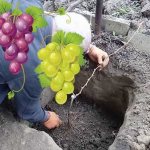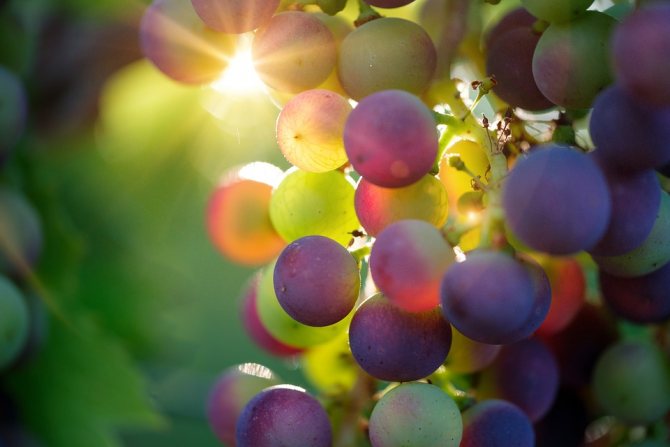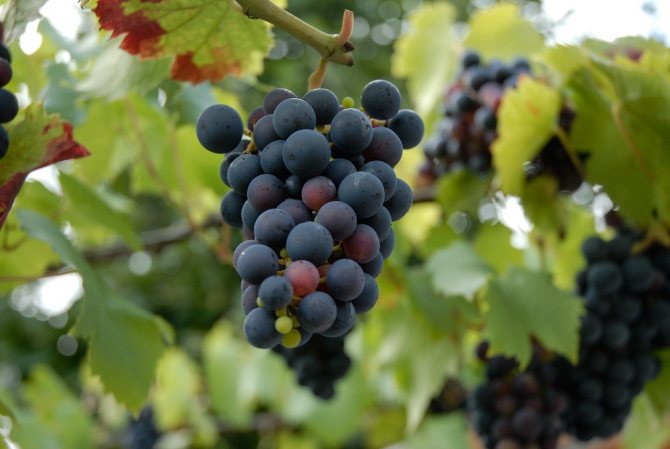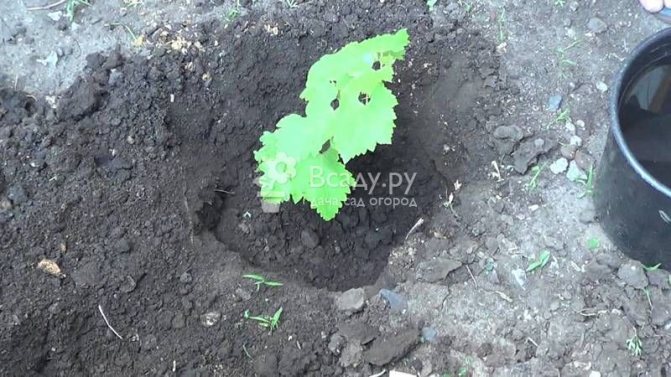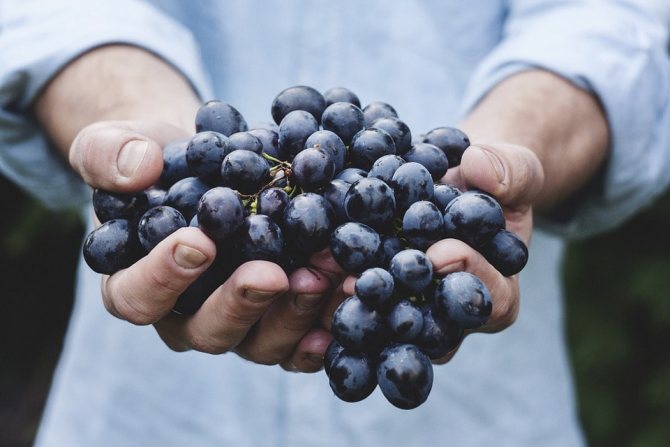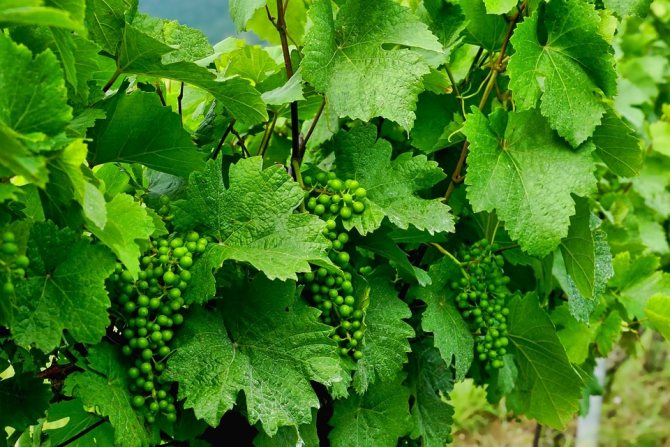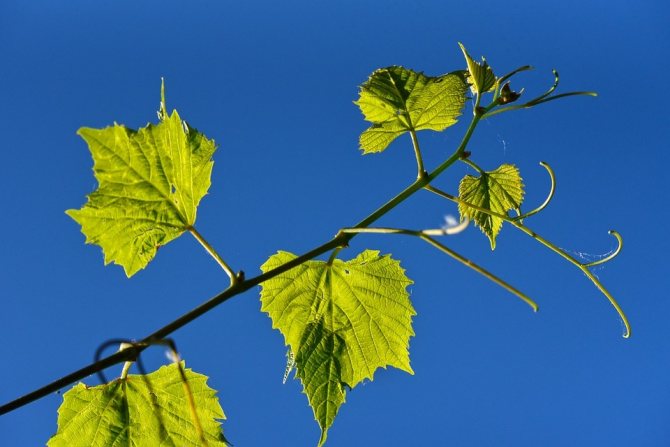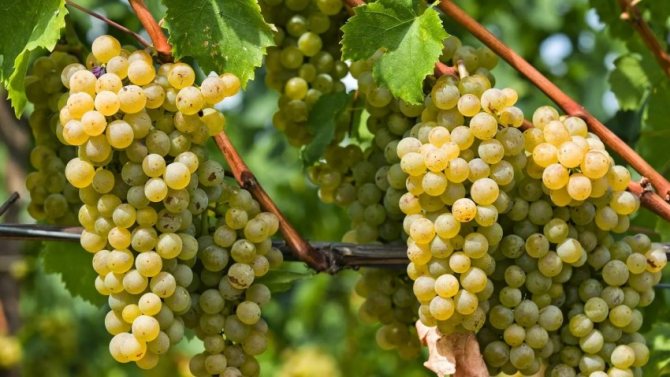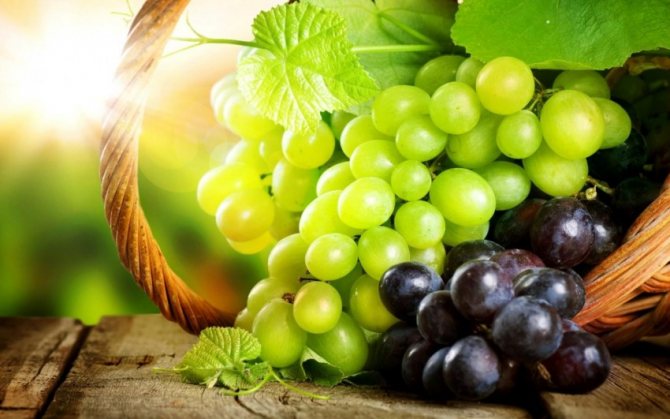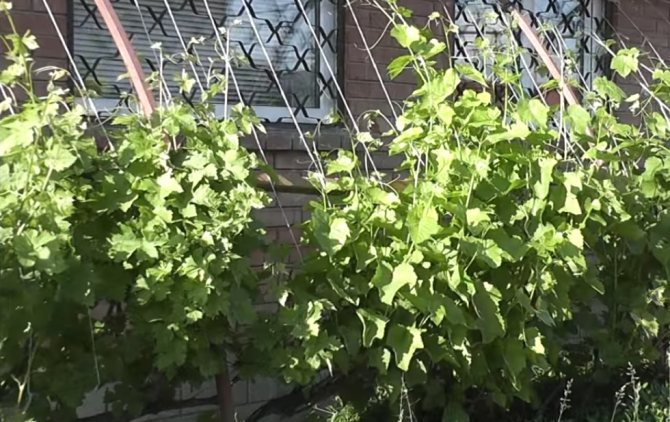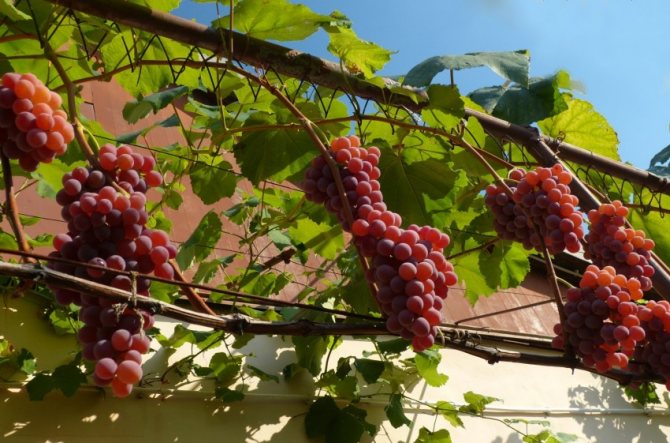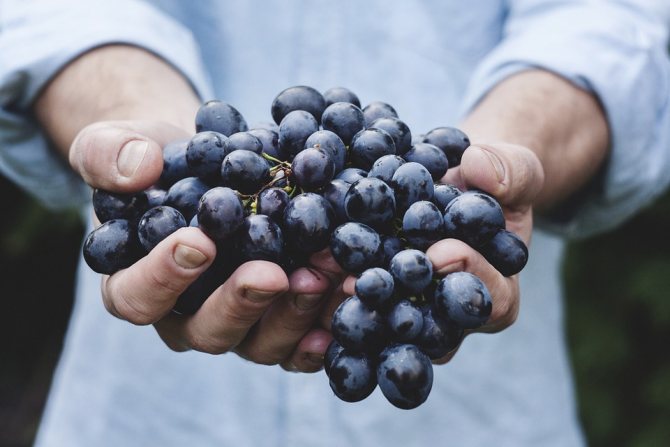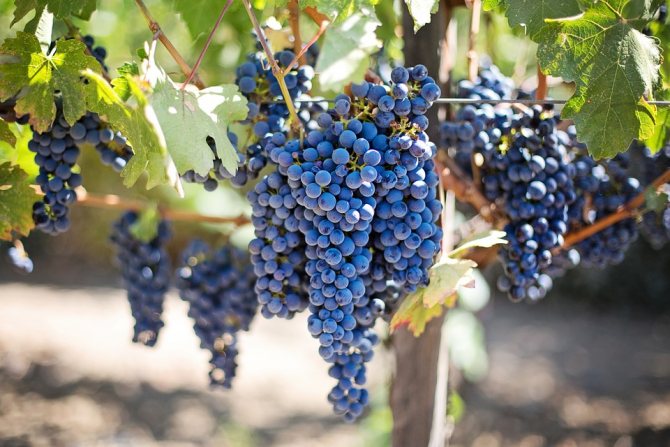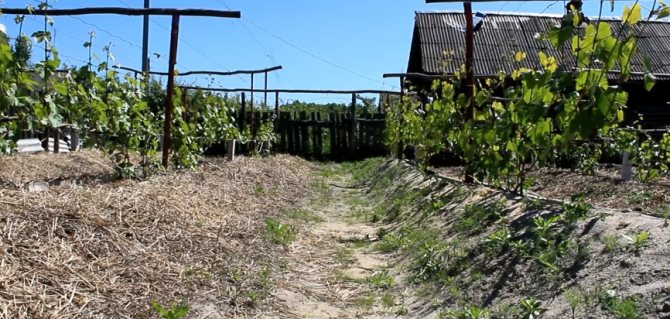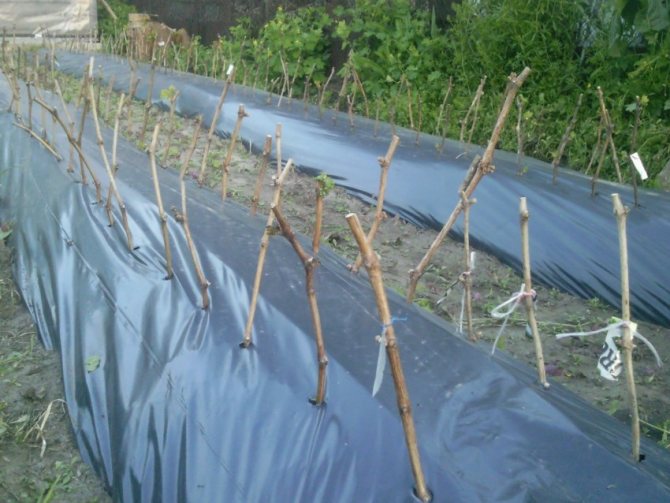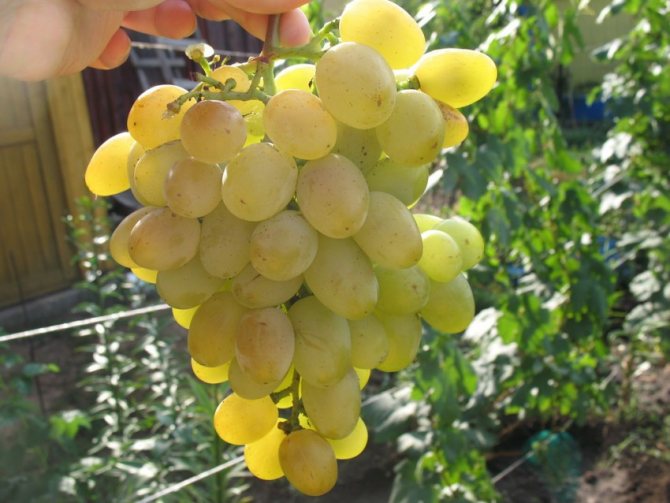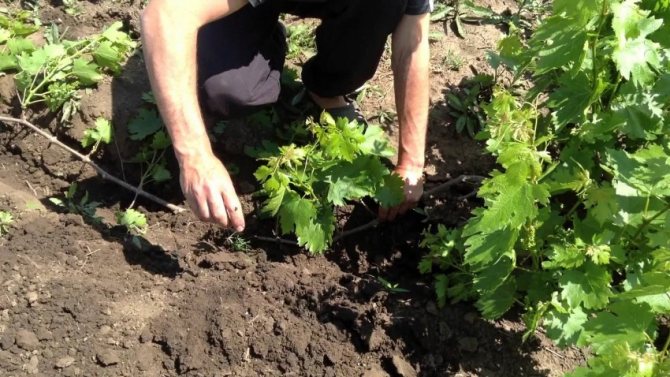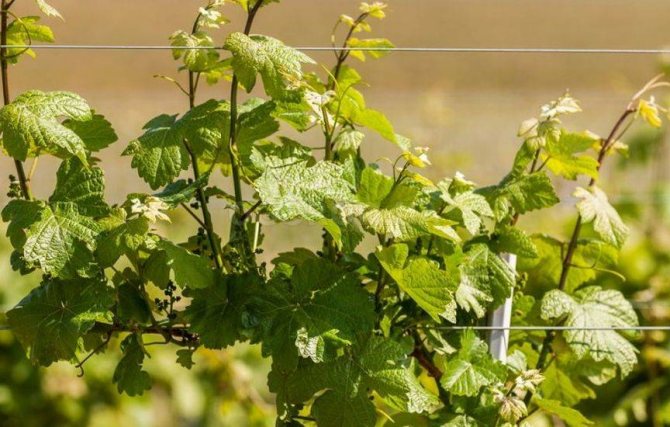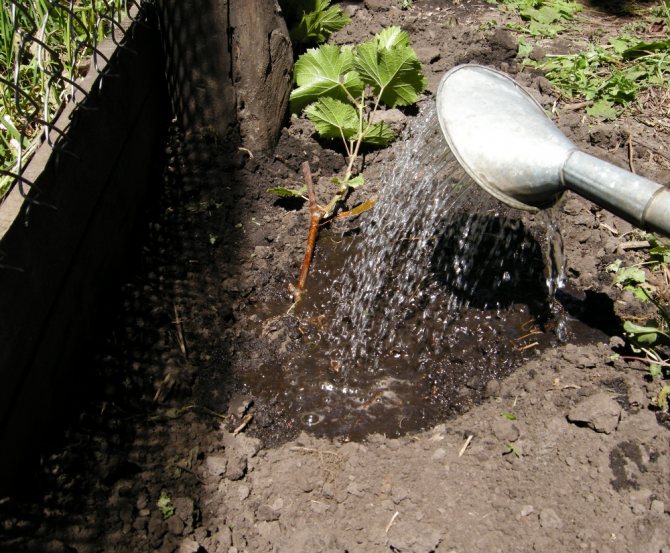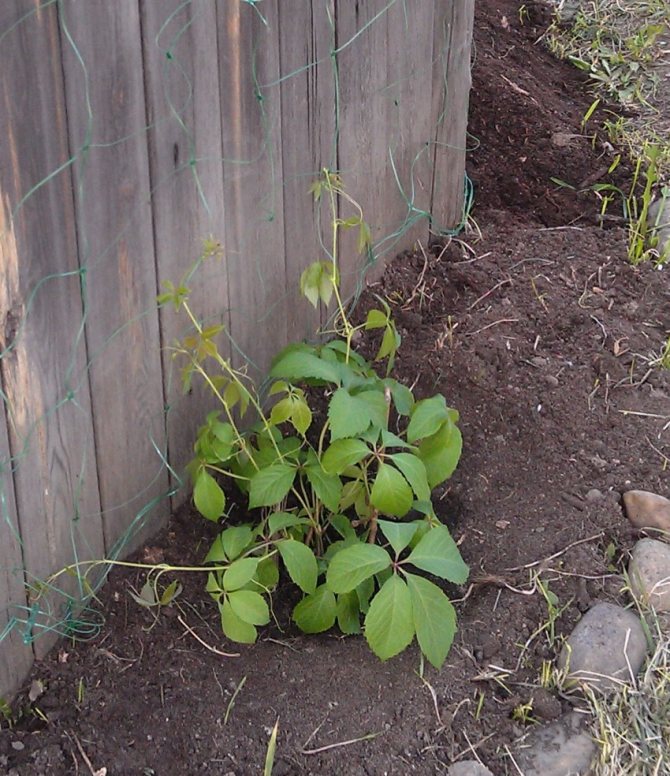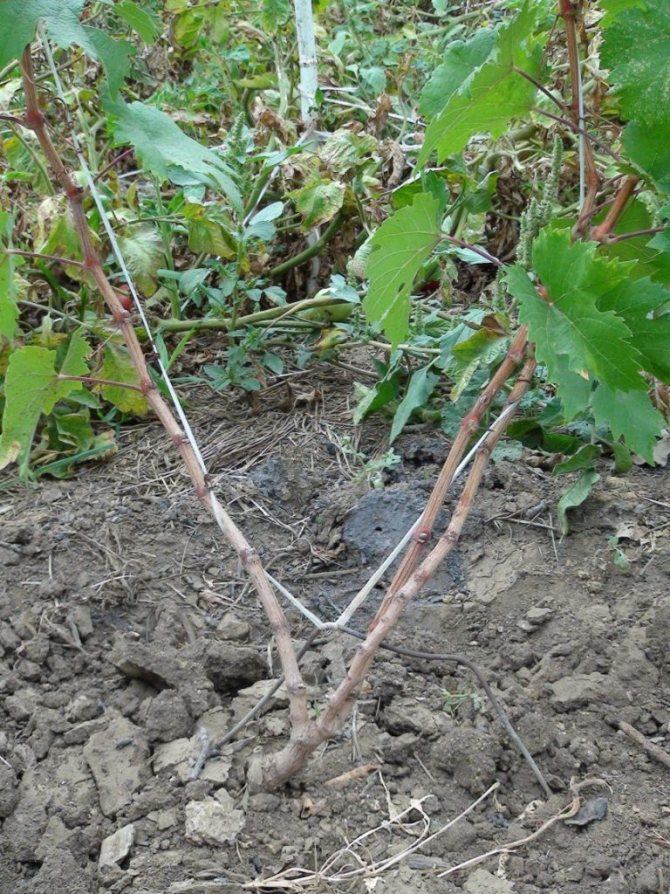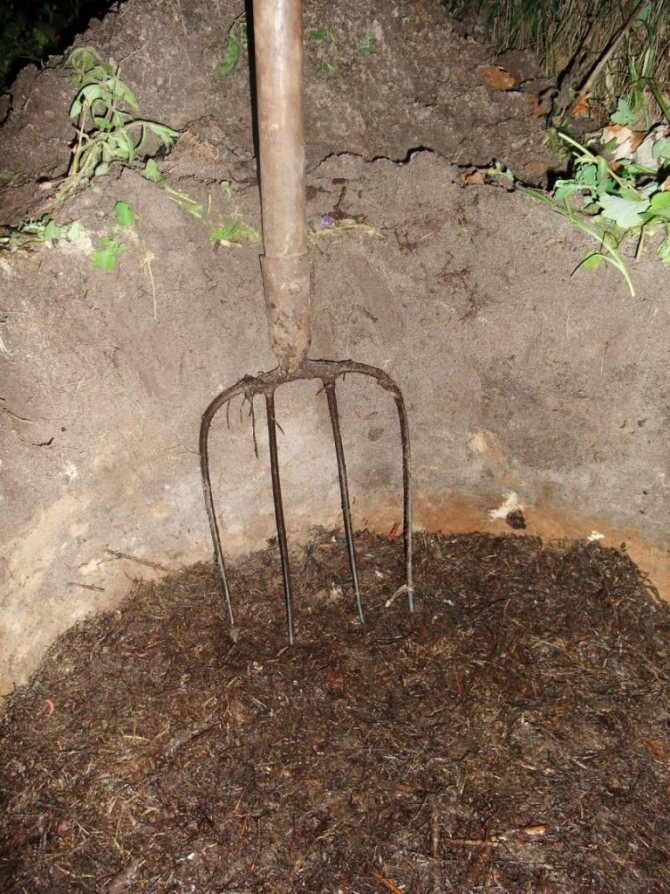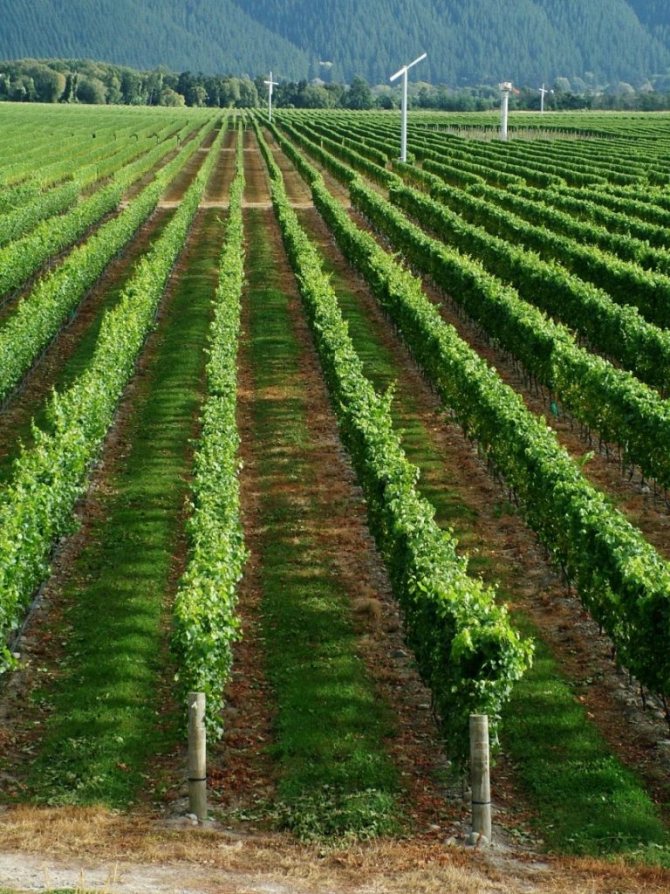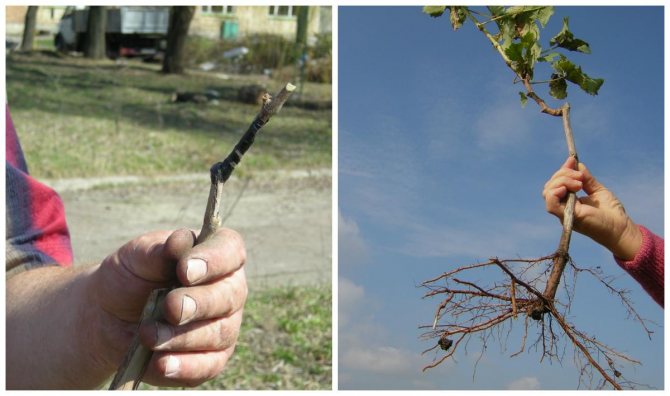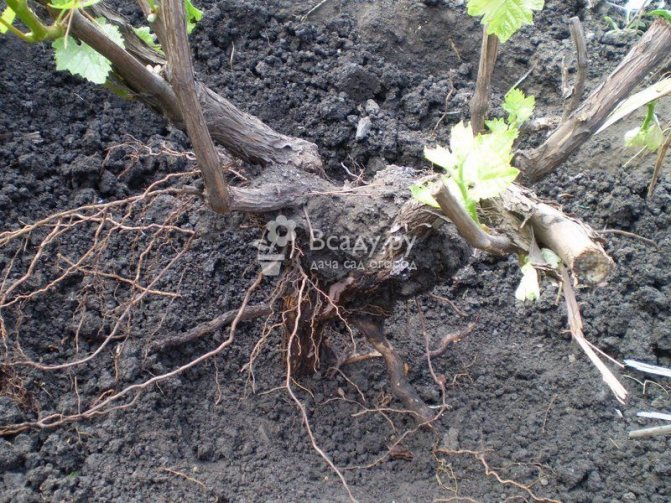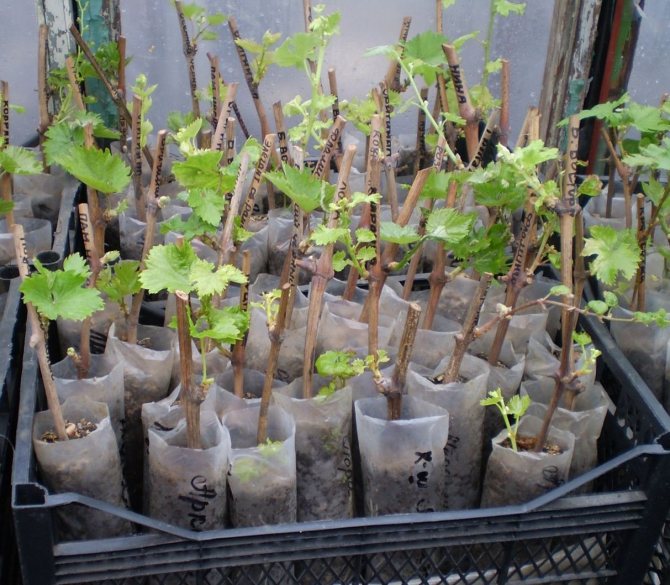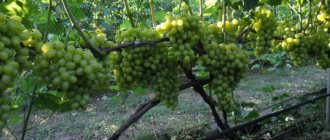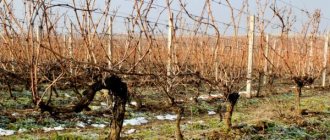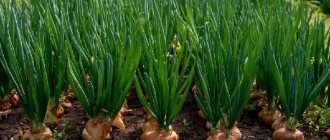You have decided to start your vineyard, choosing the spring period for this. Obviously, you want the grape bush to quickly take root, start actively growing and developing, in order to give the first decent harvest in 3 years. What is needed for this? Of course, initially to plant according to all the rules.
Below you will find all the necessary information about when and how to properly plant a grape seedling in the spring, what preparatory measures need to be taken before direct planting into the ground, what care will be required after planting.
Important! If you you bought grape cuttings, you want to germinate and plant them in springthen it will be more useful for you this material.
Optimal planting times in different regions
Grapes are very popular in the Moscow region and central regions. Here you need to focus on the weather conditions, but in general, planting begins in the second half of May. You can plant plants in late April and early May, but then the seedlings are placed in a greenhouse.
The earliest planting begins in the South, where already from the second half of the month, growers are planting cuttings and seedlings with might and main.
In Siberia and the Urals, it is necessary to engage in spring planting of grapes 2-3 days after the standard planting date, when the frosts have passed and the plant is not in danger.
Lunar dates
In the current 2020, according to the lunar calendar, the most favorable period for planting seedlings of the selected grapes is the month of April, or rather the period from the 11th to the 17th, and from the 21st to the 26th.
April is the best month to plant, so it is worth carving out some gardening time these days to enjoy your favorite grape variety in the future. This can not always be done, but if these days it does not work out, then you should at least avoid gardening at unfavorable times, and according to the lunar calendar 2020. The following periods are considered as such:
- 6, 7 and 21 in March;
- 5 and 19 in April;
- 5 and 19 in May;
- 3, 4 and 17 in June.
In 2020, auspicious days for planting grapes will be:
- March 3-5;
- March 17;
- March 27-28;
- April 1-2;
- April 7-8;
- 14th of April;
- April 28.
Among the unfavorable days of 2020:
- March 14th;
- March 22-23;
- April 19-22.
What soil is most favorable for planting and growing grape cuttings?
A very important issue is the type of soil for growing grapes. It must be said right away that in any case, the soil for grapes must be well cultivated. For the full growth and development of a grape plant and a normal harvest, the depth of the fertile layer should be about 80 cm, and the acidity should be at a pH level of 5.5-7.0.
The best option are soils for grapes of medium texture - loam and sandy loam, underlain by moraine loam. These are deep, sufficiently water-absorbing and rich soils. Lighter, sandy soils have a low moisture capacity and are poor in nutrients. But the most important thing is that the temperature of such soils greatly depends on the air temperature, that is, in spring and summer they quickly warm up, sometimes excessively, and in autumn and winter they cool down just as quickly and freeze to a great depth. A similar situation is observed in drained peatlands.In addition, peat soils are acidic, and any work on them must begin with liming in order to raise the pH level to the optimal value.
Such soils are unsuitable for planting grapes without radical improvement for grapes. Clay soils are sufficiently water-absorbing and rich. However, they slowly warm up and cool down. And although in autumn the roots are protected from a sharp drop in temperature, in spring, due to the cold soil, the beginning of the growing season is delayed.
Heavy soils are not suitable for grape cuttings, as they are poorly aerated. And the development of the root system in a compacted environment is difficult. In some cases, the clayey horizon is located at a shallow depth from the surface, which also prevents normal root growth. In any case, before planting grapes on such soils, it is necessary to carry out a number of measures to domesticate them.
Knowing that the soil is needed for grapes, you can start preparing the planting pit.
Pros and cons of spring planting
Of the main advantages of spring planting, the following are worth noting:
- Acceptable temperatures. In the spring, especially in April, there is no need to experience relatively serious frosts, so the risk of the seedling dying after planting is eliminated.
- The survival rate. Thanks to good weather conditions, the seedling goes through the adaptation period perfectly, takes root, and due to this, its resistance to low temperatures significantly increases. He's kind of tempered.
- Preparation. There is a lot of time for the advance preparation of the soil, which will have time to be well nourished with useful substances during the winter. Over time, they will move on to grapes that are better able to cope with weather conditions and even parasites.
Along with the pluses of spring planting, there are also minuses:
- Treatment. Before planting a seedling in the spring, it is required to cultivate the land from harmful microorganisms and parasites, which wake up and become active just in the spring.
- Weather. Forecasters find it difficult to predict recent weather conditions, so the risk of frost in early spring still remains and this must be taken into account.
- The choice of the variety. The choice of varieties in the spring is rather scarce, as growers try to sell them in the fall. We'll have to buy seedlings in the fall and take care of them before the spring planting period.
The planting time should be chosen based on personal capabilities and preferences, then at any time the grower will have wonderful plants.
When is the best time to plant?
Grapes are a thermophilic plant. It requires careful maintenance and high temperatures outside the window. Therefore, you should not start planting and buying seedlings even before warm weather is established in your region.
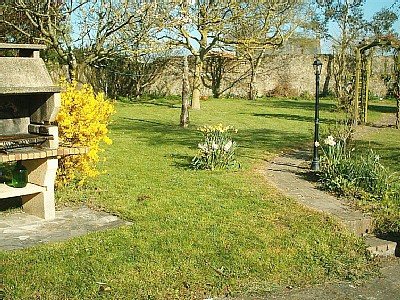
Planting before April is an unjustified risk
Also, the type of root system plays a huge role in the timing of planting.
Table 1. Types of root system.
| Root system type | Features of the |
| Closed | If you are dealing with grapes with a closed root system, then it is better to plant in advance, in April. It is important to comply with the temperature standards. Make sure that the weather forecast pleases you during the week with freezing temperatures. It is also important to ensure that there is no heavy rainfall during this time, such as squall winds, rain or snow. If the temperature has settled, and the weather is sunny outside, you can start planting seedlings. |
| Open | If we are talking about an open-type root system, then here the issue of timing should be approached even more carefully. The fact is that this grape is susceptible to low temperatures and any negative change in the external environment can destroy the seedlings. In order to hinder this process, it is better to land in late May - early June.At this time, the temperature on the thermometer should be stable at least 25 degrees Celsius. Also, the presence of precipitation is excluded. |
Preparing the land for planting seedlings
Seedlings should not be planted in unprepared soil. Otherwise, they will rebel, grow poorly, and may also die. Special attention should be paid to preparation even in advance, in the autumn period, when there is an active harvest.
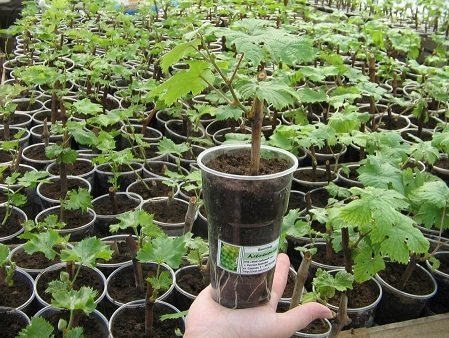

Good preparation is the key to yield
- Determine in advance the place where the grape seedlings will be located. Make sure that there are no spreading trees or strong bushes nearby. Otherwise, they will take nutrients, minerals and moisture from the grapes.
- The next step is to dig a planting hole. In depth, it should reach 40 cm.The diameter of each pit is about 20 cm.
- You need to fill the drainage down. Crushed stone and sand are perfect.
- From above, the drainage must be covered with earth. You do not need to fill up the fertilizer, because you will be performing the conservation procedure.
Important! The procedure for preserving the blanks of holes for the winter is that you need to cover the holes, and sprinkle them with earth on top. So its walls will prepare for the adoption of seedlings for the next season.
The next stage of preparation begins 4 weeks before planting the seedlings. Regardless of the weather conditions, you need to deepen the fertilizer intended for your specific grape variety into the pit. Fertilizers are distributed not only along the bottom of the pit, but also along the walls. Sprinkle with earth. And then you wait a month when you can land.
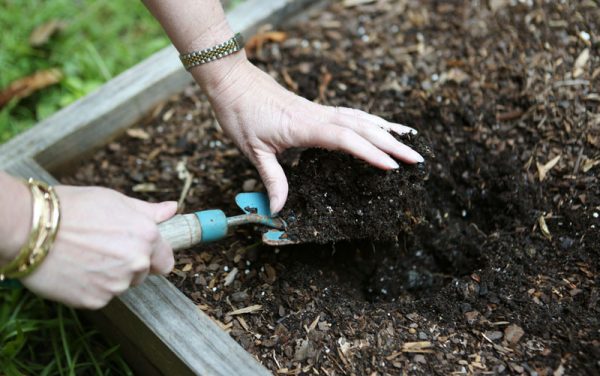

Preparation is carried out according to the instructions
But even if for some reason you have not carried out the preparation of the land in the fall, do not worry. It is necessary to make preparatory measures 2 months before planting the grapes. Therefore, you still have time to do everything according to the rules.
Pros and cons of planting grape seedlings in spring
If you are a budding gardener, you are probably wondering when is the best time to plant. Some are leaning towards the fall option, and there are plenty of pros and cons here as well. Others, on the contrary, believe that the spring period is most favorable for deepening seedlings into the ground.
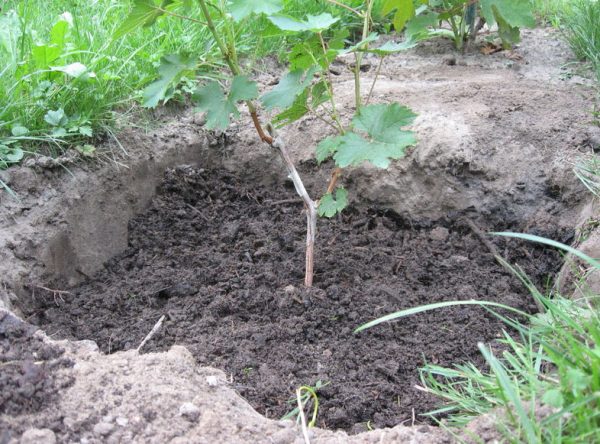

It's pleasant to work in the spring - this is the main plus
So what are the advantages of planting grape seedlings in the spring?
- The first and most important plus is the high probability of survival of the seedling. Warm temperatures, bright sun, saturation of the earth with nutrients play their part.
- The second important point is that the grapes are protected from frost. But 40% of seedlings die from its harmful influence.
- In the spring-summer period, while the seedling is only accepted and is quite vulnerable, it is protected from rodents, hares, pests, since there is a lot of food around, and there is no need to get food from the seedlings.
- And finally, you can always re-plant in case you see by the middle of summer that the seedling has not begun.
But there are also disadvantages that discourage gardeners from the decision to plant in the spring.
The sun is sometimes merciless
- In some regions, the summers are quite hot. It literally burns everything in its path. Young grape seedlings with delicate leaves cannot always withstand the hot sun, dry up, and their root system, on the contrary, can rot.
- In the summer, other plants begin to grow and develop along with the grapes. They feed not only on moisture, but also on nutrients and minerals from the earth. It turns out that they will fight with grape seedlings for useful components. Due to their youth, the grapes will lose this battle and can wither away without fertilizers and proper care.
Based on these pros and cons, each gardener must decide for himself when, in his opinion, to plant grape seedlings optimally.
Choosing the right variety
Many beginners miss the moment of choosing a variety, which is a gross mistake.It is important to select a variety according to the characteristics of the weather in a particular region and personal preferences in terms of not only taste, but also care.
To begin with, it is worth understanding the ripening time, since different regions have different temperatures, and climatic conditions are not always suitable for the grape variety. The fruit may simply not ripen if there is not enough heat.
Frost resistance and weakness to various diseases are considered important indicators. Choose complex resistant grape varieties and various hybrid forms that have the most attractive characteristics. You can find out about the best frost-resistant grape varieties from this article.
Pre-planting preparation
The first step is to prepare a suitable area with good soil for planting grapes.
Site preparation
It is recommended to plant grape cuttings in spring or purchased seedlings with roots in a well-sunlit area, since grapes are a light-loving culture. At the same time, it is important that the vineyard is located in a windless place.
Grape cuttings are planted in spring in two ways:
- planting into sandy ground is carried out by laying seedlings in a dug trench;
- on loamy soil, it is recommended to plant grapes on the ridges.
Spring planting of grapes in an area with a close passage of groundwater is not recommended: a low-lying area will not be able to grow a good vineyard, moreover, it will bear poor fruit or even die from an excess of moisture.
It is necessary to plant grapes in fertile soil in spring. If there is no fertile soil on the site, you will have to prepare it. In this case, the planting material is planted in a fertile pit.
To prepare a fertile pit, you will need loose, light, and humus-rich garden soil with a neutral pH level.
Disembarkation dates
Spring planting of branches with roots or grape seedlings in open ground in different regions of the country is carried out at different times. The main condition for planting is a favorable air temperature (15 ° C) and soil (10 ° C).
The optimal landing time for the southern regions is late March-mid-May, in the middle lane - the second half of April-early June.
Harvesting a pit for planting
To prepare, the hole is not only dug, but also fertilized correctly. A planting pit for planting seedlings and shanks is being prepared in the fall. It is fertilized with nutrients. The optimal size of the landing pit is 80 cubic meters. see This space is enough for planting roots and fertilizers in subsequent years of growing seedlings.
During the excavation, the soil heaps are divided into 2 parts. One pile will go under the top layer, the other will be used for the bottom layer. The layer of the planting pit should not exceed 10 cm. The first layer of earth is laid on the bottom of the planting pit, since it is the most nutritious. After that, a layer of nutrient mixture with a depth of 10 cm is laid. For its preparation, 40 kg of manure, 0.5 kg of nitrogenous fertilizers and 0.5 kg of wood ash are taken. On top of this mixture is laid 10 cm of fertile garden soil. Everything is mixed, a layer of fertile soil is poured on top. Laying the ground is carried out until a distance of 20 cm remains to the top of the pit.
Such a planting pit for planting grapes during the winter will absorb moisture and, together with nutrients, will become an excellent base for growing a young vineyard.
What should be the seedling?
There are two types of seedlings: vegetative and lignified, while before choosing, you should familiarize yourself with the main characteristics and features of each type:
- Under vegetative understand the stalk that was planted in early spring. It is often called green because by the time of the next green, when planting should take place, usually the stalk already has several green leaves.
- Lignified seedlings are called a year-old bush of grapes. In the fall, it is dug up, after which it is stored in a cool place and always in wet sand. To preserve it, it is important that the humidity percentage in the room throughout the entire time does not fall below 85, because under other conditions mold and other microbial organisms can develop.
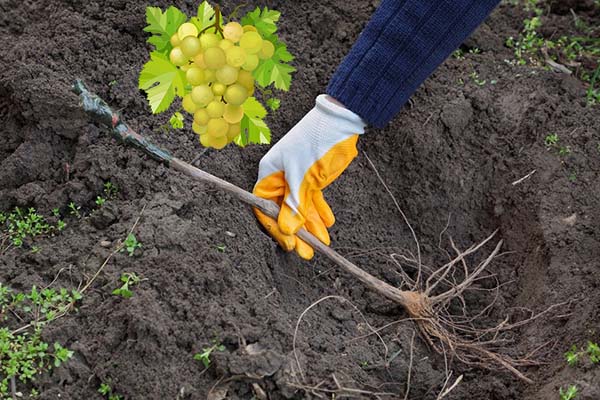

Save until spring
To minimize the risk of purchasing low-quality planting material, it is recommended to buy it in the fall and keep the grape seedlings until spring. The question arises: how to preserve grape seedlings until spring? A popular and inexpensive storage method is in wet sand in a dark and cool place. It is used by both amateur gardeners and manufacturers. In addition, this storage method provides constant free access to seedlings, which in case of a critical situation allows you to take prompt measures to save them.
For storage of planting material, a special fence is equipped along the wall and filled with sand. Another option is to use buckets. If several varieties of seedlings are collected in one place, then do not forget to make tags with names.
There are no special requirements for arranging storage and caring for seedlings during the winter. The main thing is to maintain the moisture content of the sand at a sufficient level. If there is an excess of moisture, the development of mold and damping of the kidneys will begin. A deficiency will cause the roots and seedling to dry out.
The advantage of storage in a cellar or basement is that you do not need to build a separate room. The seedlings move in the neighborhood with other inhabitants of the winter storage, be it carrots or potatoes.
More attention should be paid to material purchased from private sellers and unknown manufacturers. Saplings can be infected with a dangerous pest - phylloxera. It is especially common among representatives of the southern regions and in the middle lane. Before storing seedlings, carry out decontamination measures.
Suitable landing site
The chosen place is of no small importance for the future grapes. It is desirable that this is a well-lit area of land where the plant will receive maximum solar energy. You should also take into account the following nuances of landing:
- Planted cuttings should be located 3-6 meters away from large trees. This rule is due to the fact that trees strongly draw nutrients from the soil, and the grapes simply will not get the necessary elements for growth. If the root system has grown too much, then the distance must be increased.
- It is recommended to plant cuttings in the southern and western sides of the buildings. So, plants will receive the necessary heat even at night - it is given off by the heat of buildings accumulated over the whole day. Cuttings will grow better and yield a good harvest faster.
- There is not always a place to place a plant near a building, and then you should pay attention to elevated areas. It can be a slope from the southwest, west and south sides.
- Do not place the cuttings in the lowlands, because frost and any temperature fluctuations are most felt there - the grapes may simply not be able to withstand.
- It is advisable to bypass places where groundwater is close to the soil.
Preparing a seedling for planting
You brought the seedlings home.
- Expand and check their root system again.
- Remove the soil from the roots.
- Thoroughly wipe the stems and roots with a cloth dampened in warm water.
- Leave the seedlings in a warm room for a few days. It will be great if it will be a veranda where fresh air will flow.
- Make sure that the temperature and condition of the wells allows planting.
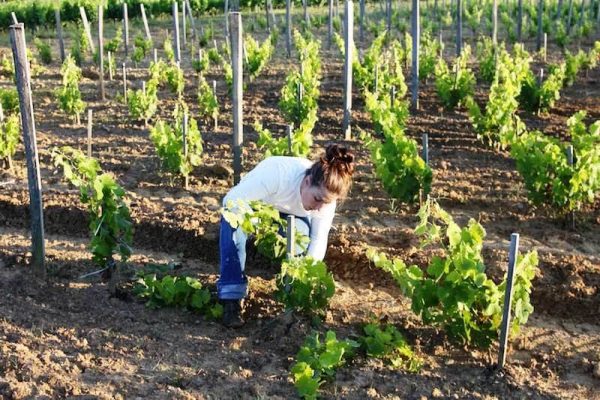

All actions must be accurate
Now armed with garden tools, do some manipulation. Namely, it is necessary in advance, even before planting, to process the grapes from pests.For this, a solution of sodium sulfate or ordinary boiling water with the addition of a few tablespoons of garden varnish is suitable. The second option is the most effective and safe for young seedlings.
- Dissolve a few tablespoons of garden varnish in 10 liters of water.
- Put on fire and cook until boiling.
- As soon as the water starts to boil, pour into an enamelled shower head.
- Leave the seedling outside.
- Secure so that it does not fall under the running water.
- Start spraying and watering the seedling with the shower head.
- Do until you think the plant is completely processed.
- Leave the seedling to dry in direct sunlight.
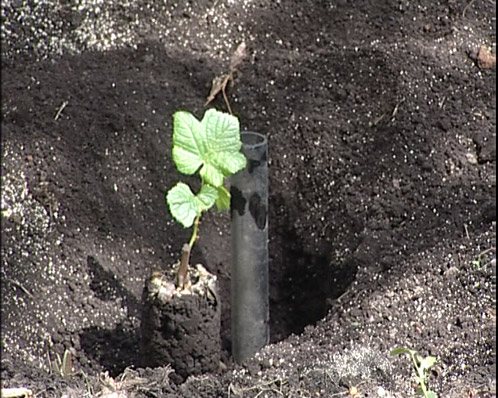

You cannot land without preparation.
Why does this procedure need to be done before disembarking? After all, many plants are scalded with boiling water even at the moment when they are only immersed in the ground? In fact, the grape seedlings are shocked to have moved to the ground. And an additional shock for them will be spraying with boiling water. Therefore, it is better to divide these procedures among themselves at least with an interval of several days.
Important! Once the grapes have dried, they are left in the veranda again for a couple of days. And after they have passed, the landing is carried out.
Grape seedlings prices
seedling grapes
Requirements
It is necessary to take into account all the requirements that will help to get a good harvest. We will talk about them further.
How deep should you plant?
Winegrowers differ greatly on this issue. Some believe that holes of 50 cm are quite suitable, others are sure that the depression should have a depth of at least a meter. In moderate climatic conditions, gardeners prefer to plant cuttings to a depth of 70 cm.
How far to plant?
The distance between the cuttings, if several seedlings are planted, must certainly be taken into account by the gardener. The distance depends solely on the type of grape. So, it is advisable to plant weak and medium-sized species at a distance of 1.3-1.5 m, and strong varieties require a slightly different approach. They require at least 1.8-2 m, and the most optimal would be 2.5 m, if the owner of the site has such an opportunity.
Insufficient distance will affect the quality and growth of the grapes, as the cuttings will not receive sufficient nutrition, lighting and ventilation. This seriously increases the risk of disease, and the yield will be significantly reduced. Also, thickened plantings age faster.
How and with what to fertilize the soil before the procedure?
In most areas, the soil does not contain a sufficient amount of natural nutrients and components, and if you choose the wrong place, then the growth of grapes remains a big question. To exclude the death of the plant, various diseases and increase immunity, it is necessary to fertilize well the site where the future vineyard will be located.
Experts recommend using mineral and organic fertilizers. You can make several layers like this:
- black soil 10-15 cm;
- a bucket of rotted manure;
- a fertilizer layer of your choice (150-200 potash, 400 g of regular or 200 g of double superphosphate);
- can additionally use a couple of cans of wood ash;
- another layer of black soil.
How to choose grape seedlings for planting
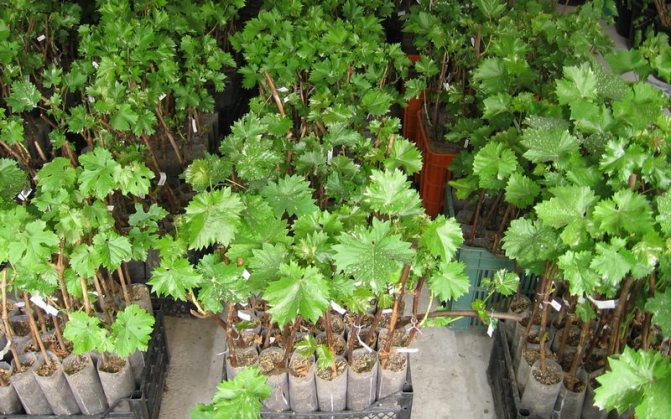

Grape seedlings in the photo
The acquisition of healthy planting material is just as important as the correct selection of the variety. Grape seedlings can be of two types: grafted or self-rooted. Subject to the technology, grapes are easily rooted by both lignified and summer cuttings. Therefore, the production of such seedlings is the most economically profitable.
The grafted seedlings are grown in those regions where there are serious problems that do not allow cultivation of their own roots, for example, under unfavorable soil conditions: increased salt concentration, high lime content, etc. In these cases, rootstocks are used that are well adapted to such conditions. In regions with severe winters with little snow, the cultivation of grapes on frost-resistant rootstocks is practiced. To remove such rootstocks, Amur grapes, which naturally grow in the Far East, are used.But the main problem that is solved with the help of rootstocks is the protection of plants from phylloxera root aphids. The damage caused by the pest is so great that it can lead to the loss of vineyards in huge areas. To avoid such consequences, grape bushes are grown on rootstocks derived from American species that are genetically resistant to phylloxera.
In the Non-Black Earth Region, there are no problems with phylloxera - these insects are not able to live in such harsh climatic conditions, so there is no need to use seedlings on stable rootstocks either. Thus, self-rooted seedlings are the best option for the middle lane. Although in the northern regions it is safer to use seedlings on frost-resistant rootstocks.
Planting material of grapes, like other crops, can be with open and closed root systems. To choose grapes for planting, as experts advise, when buying seedlings with an open root system, you should first of all pay attention to the quality and condition of the roots. The main thing is the presence of heel roots located on the lower part of the cutting - there should be at least three of them. It is good if the thickness of each is more than 2 mm. With a root diameter of less than 1.5 mm, the seedling is considered non-standard. Before planting grapes, pay attention to the roots: they should not be too short, dried, or have damage and signs of disease.
If the root system is strong, with lots of healthy roots, the seedling can be purchased even if it is not too large. But in general, the height of a standard grape seedling for planting in the ground in the spring should be at least 40 cm. The height of the seedling is made up of the length of the cutting and the length of the annual growth, which was formed in the year of rooting.
The stalk itself can be ordinary, with six nodes. In this case, its length is already approaching 40 cm, which means that, together with the growth, the total height of the seedling should be about 55 cm.If, however, a shortened stalk with 2-3 eyes was used for reproduction, then this is also okay if, of course, annual growth is of normal size and appearance. A full growth must certainly be well matured and have at least four well-formed eyes.
Before preparing grape cuttings for planting, carefully watch for signs of disease and mechanical damage. When going to a nursery or garden center for grape seedlings for planting in spring, you should stock up on packing material.
If there is no confidence in the correct storage of the seedlings before the sale, it is better to refuse to buy the plants. Seedlings with a closed root system are more preferable, they take root well, the planting of such plants can be carried out in a longer time frame. They can be left without any problems, for example, in a greenhouse, on a terrace or even on a loggia until the optimal planting time. Such planting material allows novice amateur winegrowers to avoid many mistakes.
However, when purchasing seedlings with a closed root system, you need to be doubly careful - after all, the roots are hidden, and their condition is difficult to assess, this is often used by unscrupulous producers and sellers. It happens that the seedling has only weakly developed roots formed in the upper nodes, and sometimes they are completely absent. You can determine the condition of the seedlings by their appearance. The easiest way to do this is when the seedling has started growing.
When choosing a plant, you need to pay attention to the general condition of all seedlings of this variety. If most of the plants already have several normally unfolded leaves, then it is these seedlings that need to be guided by. But the seedlings, in which the eyes have just begun to bloom or the shoot is very small, with folded leaves, or the leaves are deformed and unnaturally colored, are practically unviable.
Even if they do not die in the first year, it will not be possible to get a good strong plant from them. If everything looks good, but the root is not visible, ask the seller to show the root system. In a full-fledged plant, you can see light, with small branches, roots. In the case when the roots are not visible on the underside or on the sides of the earthen clod, the seedling is not worth buying.
When buying seedlings with leaves in containers, it is important that the leaves are intact, not too small and without signs of damage from diseases and pests. Of course, the bushes can be processed, but such plants are already weakened, it will be more difficult for them to take root and prepare for the coming winter. In addition, diseased planting material can serve as a source of infection for other plants.
Also, in some cases, the leaves can be used to determine whether the seedling corresponds to the specified variety.
To make it easier to prepare the grapes for planting later, inspect the seedling as carefully as possible for cracks, thickenings on the stem, for sluggish or dried leaves and shoots, for the presence of mold and unnaturally colored spots, all this may be a consequence of the development of fungal diseases. It is undesirable to bring such a plant to the garden - there is a high risk of spreading the infection. And in order to minimize the possibility of error when choosing a variety, you need to familiarize yourself in advance with the morphological features of the plants you are interested in. After all, the shape of the leaf blade is a varietal trait, and in some cases the plant itself will "tell you" whether it corresponds to the variety indicated on the label or not. This, of course, will not help when buying dormant seedlings, or if the desire to plant a grape bush appeared spontaneously when visiting a nursery.
Watch a video on how to choose grape seedlings for planting:
Preparation of planting material
The choice between a seedling or a cutting depends solely on the needs and wishes of the owner of the site, but you will have to prepare the plants in any case.
Cuttings (shanks)
First you need to leave the cuttings in a calm state at home for a few days. It doesn't matter if they are purchased or were dug out by the grower in advance in the fall. They have to adapt slightly to temperature.
If the cuttings are grown and prepared on their own, then you need to check their condition for mold, darkening or painful spots. If mold is found, they can be washed in a solution of potassium permanganate, in which disinfection is also carried out for 30 minutes. This can be done even if the cutting is in perfect condition. After half an hour, the cuttings are washed with ordinary running water.
The next step is slicing to update the slices. At the same time, the growers check the middle of the cut along the way, noting the color. The black and brown dry middle can be considered dead. Make sure that the cuts are smooth.
After that, soaking, furrowing, treatment with a rooting stimulator are carried out and even then they are put on germination.
For information on how to root a grape stalk, see the following video:
Saplings
With seedlings, the situation is a little easier. Preparation begins in 1-2 days, it includes competent pruning of the root system and soaking in a growth stimulant solution.
Sometimes the purchased stimulants are replaced by winegrowers with a solution of honey and water in the proportion of 1 tbsp. l. for 1 liter. This will provide the seedling with a great start and will allow it to quickly take root, which means it will strengthen.
Disinfection methods
- Fumigation (or fumigation). Fungicides and insecticides are used, for example, sulfur dioxide, a poisonous gas formed as a result of the combustion of colloidal sulfur. The seedlings are placed in a closed space (it is important that the floor level is above ground level) and the colloidal sulfur spread on metal trays is set on fire. Fumigate for 30-50 minutes. The amount of sulfur per 1 m3 is 50-100 g. Then they open and ventilate.It is important to remember that sulfur dioxide is toxic to humans and animals. Therefore, observe the safety rules when working.
- Disinfection by the method of professor P.P. Radchevsky. For 1-2 days, the seedlings are kept in water at room temperature. Then they are sealed in plastic bags for 3-4 days. If the seedling is infected, then under artificially created favorable conditions, the pest is activated. After the seedlings are treated with a solution of organophosphate pesticide and again closed in polyethylene for a day.
Methods for planting seedlings
There are many ways to plant grapes and each of them has its own disadvantages and advantages, which should be guided by when choosing.
Classical
In the classical method, the seedlings are washed well before planting. Cut the container (if it was in the container), put the seedling on the bottom of the pit, and on the north side a peg for tying, cover the plant over the earthen coma, compact and watered with warm water. Next, the pit is filled up to the height of the first leaf, but this is after watering.
About the features of planting grapes in spring, see the following video:
On the trellis
This method allows you to organize your vineyard well. For this scheme, it is necessary to prepare the place in advance by installing the trellises in the required order, depending on the number of seedlings. And then the landing takes place, as in the first option.
Observe a distance of at least 2 m, make the supports from metal pipes with a diameter of 10 cm. For tying, a wire with a diameter of 5 cm is used - it is important that it is in a plastic sheath.
On the ridges
This method is well suited for northern regions, as it provides maximum warmth and excludes flooding. To begin with, prepare a trench (located in the southern direction) 10 m long, 1 m wide and 30-40 cm deep.
After that, soil is poured above 30-35 cm from the ground, mulched, insulated, heat-supporting material is placed, cuttings are planted 40 cm deep. A metal pipe with a diameter of 30 cm is used as irrigation.
In the greenhouse
Planting in a greenhouse differs only in that the seedlings are watered once a week and are well insulated. It is advisable to reduce watering as flowering and fruit formation.
Into containers
In the northern regions, grapes are planted in containers. To do this, the cuttings are planted in plastic bags without a bottom, but they must be placed on a suitable pallet. Their standard size is 30 by 40 cm. Humus and deciduous soil are used as soil, before planting, the roots are sprinkled with clay and manure (you can use Kornevin), left for storage at home.
When the first buds appear, the packages are sent to an area located in the shade for a couple of days, after which they are moved to a sunny area. When the weather becomes warm, and the most suitable for planting grapes, the seedlings are buried in the ground.
Moldavian
A long vine is twisted and tied with a strong rope, after which it is planted in a hole. In this case, no more than 2-3 buds are left on the surface. Plant care is the same as with the classical method.
Thickening
When thickening per 1 sq. m is grown at least 7 bushes. This method is more suitable for warm areas. The branches are cut short enough, planted in the classical way, grown in bush form.
How to properly plant grapes in the fall?
To plant grapes in the fall, follow the same steps. The holes are dug, fertilized and watered in advance so that the earth is compacted. The fertility of the soil will have a positive effect on the rate of survival of the vine, the activity of growth and development of a young seedling.
The advantages of planting grapes in autumn are as follows:
- seedlings are not stored, but are planted immediately, the risk of spoilage and morbidity is reduced;
- the root system is sufficiently developed to take root well;
- autumn seedlings are more resistant to early diseases and pests.
The gardener's calendar will help determine the timing of the autumn planting of grapes. Auspicious days are:
- in October - 2, 9-13, 29-31;
- in November - 5, 11-13, 18-18, 21.
Before planting, prepare the seedlings:
- soak the planting material for a day in clean water;
- leave one healthy shoot, remove the rest;
- cut the roots to a length of 15–20 cm.
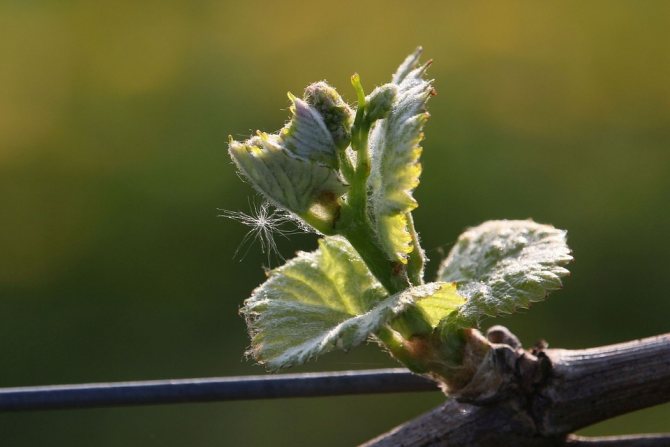

Photo:
We plant grapes like this:
- Place a seedling in a dug hole 30–40 cm deep so that the lower bud is at ground level. This arrangement will allow the bush to form correctly and simplify the laying of branches under a winter shelter.
- Sprinkle with black earth and pour 2 buckets of water. As soon as the water is absorbed, add more loose soil, do not compact.
To protect the young bush from freezing, a winter shelter is being built. There are three ways to protect the vine:
- Hilling.
An earthen mound 20–25 cm high is poured around the seedling. For shelter, take loose, moderately moist soil. The air in it does not conduct heat well and serves as thermal insulation.
- Half shelter.
This is the protection of the part of the plant close to the soil. The shoot is wrapped in burlap, old cloth, straw, and the root system is sprinkled with earth.
- Full cover.
This method of frost protection is considered the most effective. After the foliage falls, the seedlings are bent to the soil, covered with pieces of old cloth or agrofibre. Cardboard and straw are used as insulation. Cover with a film from above, sprinkle with earth, fix the shelter with metal arcs stuck into the ground.
If the method of shelter is chosen correctly, the grapes in the garden will survive any winter.


Photo:
Follow-up care of grapes after planting
After planting grapes, it must be carefully looked after. How to do it correctly, we will talk further.
Watering
After planting, at least 10-14 days must pass for the first watering. It is advisable to do this in the evening and pour 2-3 buckets of warm water under the bush. Subsequent watering occurs two weeks later, and then one should proceed from the drying out of the substrate.
Loosening
Loosening is considered a mandatory step in caring for grapes, since this way the substrate allows air to pass to the root system. They loosen the earth periodically, you can exclude this moment if you sprinkle the earth around the plant with a light layer of straw or hay.
Top dressing
With proper planting, there is no need to constantly fertilize the ground. This is only required if the soil was poor and the grapes grow rather slowly and poorly in general. Then organic and mineral fertilizers are used, which are diluted in water. Usually, the manufacturer indicates the dosage on the package and they should be adhered to.
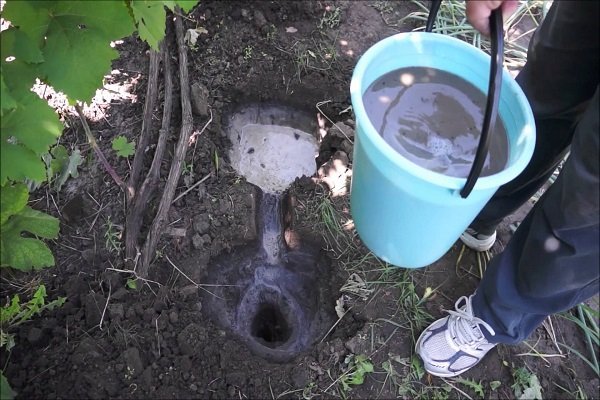

For more information on what top dressing is suitable for grapes in spring, read the next article.
Treatment against pests and diseases
Spraying grapes in the spring from pathogens must be carried out before bud break. Experts recommend using fungicidal preparations that treat not only the vine, but also the sleeves, trunk and ground at the base. If there are many pests, then the procedure should be repeated after 10 days.
Pruning
Pruning is done in early and late summer. The rootstock is removed, as are the upper roots of the seedlings. An important stage is the cutting of the first roots from the surface, for which the topsoil is removed to a depth of 20 cm.
After the work done, the pit must be filled up again. You should not get carried away with pruning, because real and complete pruning is done only at 3 years of plant growth.
Garter
With long vines, the garter is carried out using long wooden pegs or trellis. You can also use metal pipes as a base.
Wintering
Warming is simply necessary for young seedlings. In winter, the grapes are laid in a trench, after which they are mulched.If we talk about the thickness, then it should be chosen according to the climatic conditions in a particular region.
In autumn or spring, when is it better to plant grapes
The optimal time for planting grapes is autumn or early spring (mid-April - second decade of May). The main risks of autumn planting are associated with the need to leave immature seedlings for the winter. Young plants will not survive this difficult test without proper arrangement of the winter quarters. Therefore, most winegrowers choose to plant in the spring.
To figure out how to plant grapes in spring, take into account the pros and cons of spring planting:
- Saplings planted in spring take root better and meet winter with already matured, full-fledged plants.
- Some grape varieties, planted in spring, bear fruit already in the second year of the growing season.
- In the spring, it is easier to correctly determine the planting date. Even beginner winegrowers will be able to plant grapes in spring. Planting grapes in the fall is dangerous due to the fact that cold weather comes unexpectedly and can destroy the plantation in the bud.
- Lack of moisture and nutrients. It is easily eliminated if the site is prepared for planting in the fall: increase soil fertility by applying fertilizers, mulching and abundant watering. It is recommended to use sawdust or humus as mulch.
- If you do not correctly determine the time for planting, produce it too early or too late, this will provoke the development of diseases and the appearance of pests.
- Lack of quality seedlings. Due to violations of storage conditions in winter, in spring, frost-bitten or dried planting material is much more common.
To study the question of how to properly plant grapes in spring is only half the battle. Good quality planting material - 50% of the success of a started enterprise. A seedling capable of growing into a strong, healthy bush looks like this:
- there are no traces of pests and diseases;
- age - 1 year;
- has no more than 3 roots 10-12 cm long and 2 mm thick.
Possible mistakes when planting grapes in spring
Even experienced growers can make the mistake of planting young seedlings. Of the most popular, it is worth noting the following points:
- strong deepening (the bush will grow poorly);
- seedlings from other regions (local climatic conditions are not suitable for them and they die);
- unsuitable place (little light, space, flooding and frost interfere with the normal growth of the plant);
- planting of strong and low-growing varieties nearby (some prevent others from developing).
How to plant?
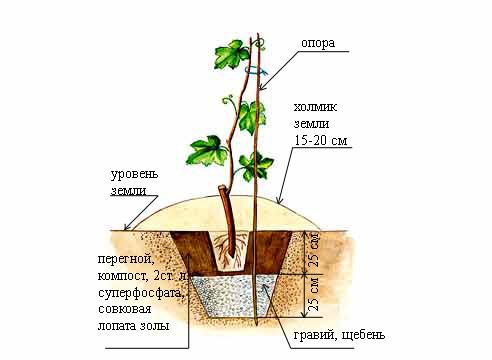

If you are planting different grape varieties, combine the bushes for this very characteristic. Division into similar varietal groupings will help to achieve bountiful harvests. And it will be easier to care for the vine.
Observe the distance between seedlings of 80 cm - if the variety is technical, and one and a half meters if the variety is table. It is necessary to leave a distance of 2-2.5 meters between the rows. This will provide airing of the shrub, non-thickening of plantings, convenience when spraying, leaving.
Check out the quality step-by-step instructions for planting a grape seedling in spring:
- In the center of the hole, a depression is made about 35-40 cm.
- Place a plastic hollow tube with a diameter of 5 cm in the hole - it will be convenient to water the young seedling with it later: the water will go directly to the roots.
- At the bottom of the pit, a slide is made, on which the seedling is placed vertically with the heel. The roots spread out along the slope of this impromptu slide.
- Sprinkle soil over the seedling, compacting the soil along the process so that no air pockets remain.
- Immediately after planting, the bush must be well watered using at least two buckets of water.
- If the seedling is green, after planting it needs to be shaded for the next 7-10 days. Protection in the form of boxes, plywood is installed on the sunny side: this will protect the delicate plant from burns.The shelter is removed only after the seedling takes root and noticeably grows.
Helpful hints and tips
Use trusted suppliers or prepare your own seedlings. It will not be superfluous to prepare the soil in advance for planting in order to further engage in other stages of care.
Try to adhere to these rules when planting, so as not to be mistaken with the depth or distance between plants, because this critically affects the growth of the seedling and the future harvest.
Plant grapes at the right time and under the right weather conditions, otherwise you can forget about a favorable outcome.
Growing grapes is a rather complex and painstaking process that requires careful study and consideration of the needs of a particular variety. However, hard work is rewarded when it is time to harvest. With the right approach, the quantity and quality of the fruit will always be at its best.
0
Site selection
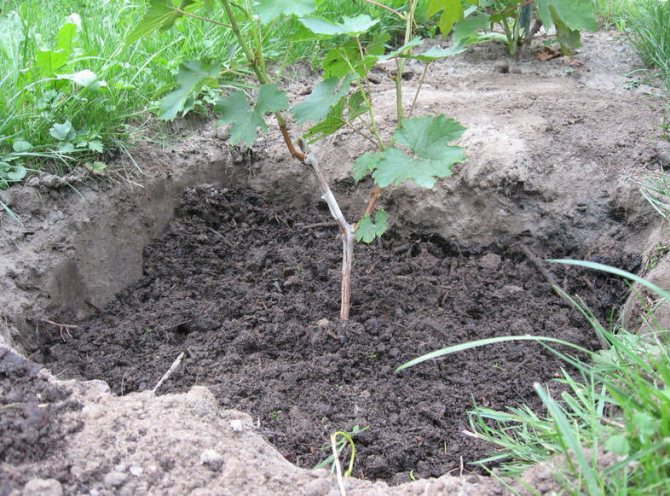

The place for planting grapes must be chosen open - well lit and heated. This culture is thermophilic, southern, so it is unlikely to grow and bear fruit well in the shade.
Ideally, the sun can illuminate and warm the shrub throughout the day. The southern side of the site, as well as the southeast and southwest, are optimal. You must try and find a similar place, otherwise you will not see a good harvest of sweet berries. If the grapes are obscured from the sun by tall trees and there are no more places on the site, you will have to sacrifice trees.
The relief of the site is also important. It is unacceptable to plant grapes in the lowlands. The fact is that stagnant phenomena in the soil are frequent in the depressions - and the roots of grapes are sensitive to excess moisture. If there are no hills on the site, make it yourself artificially.
The soil should be nutritious, saturated with fertilizers, humus. In addition, the soil under the vines should be well-drained, light, and permeable. Acidity is neutral.
Step-by-step instructions for planting grapes in spring and autumn
The technology of planting grapes with seedlings requires taking into account certain nuances and following step-by-step instructions. At first glance, the rules of procedure may be confusing with their complexity and multistage, but in practice everything turns out to be much simpler. But, most importantly, follow the instructions and the procedure for performing the procedure in spring and autumn. Then you can study the necessary information and try in practice.
Choosing the right place
Before starting the event, you need to choose a suitable place in the garden for planting grapes. The success of growing crops and productivity depends on this. Therefore, when choosing a place, you should pay attention to the following nuances and conditions:
- Cultivation on swampy soil and in lowlands is excluded.
- Should not be planted on the north side of the plot.
- A place with strong winds and drafts is unacceptable, especially if the wind is from the north side.
The most ideal option is a place in the garden on the south side, which is fenced off by a wall or dense hedge.
- You cannot choose shaded places, for example, if you are too close to trees, buildings, fences.
- You should not choose a place near fruit crops. When planting, the distance between grapes and fruit crops must be at least four meters!
- A very important criterion when choosing a site is the soil. The soil should be fertile, loose, and have good moisture and air permeability. But do not be upset if there is no such land on your site, because you can prepare the soil for planting and create normal conditions for the seedling. If the soil is sandy or stony, then humus should be added to the planting pit, and if the soil is peaty or clayey, then a drainage layer should be added to the bottom of the pit (for example, crushed stone, expanded clay).
Planting pit preparation
The preparation of the pit for planting grapes begins two to three weeks before the event. If you carry out the procedure without preliminary preparation, then the soil will settle and compact over time, because of this, the bush will find itself below the required level.
To properly prepare a pit for planting grapes, you should proceed as follows:
- First of all, you need to dig a square hole: its depth and width should be about 80 centimeters.
- Divide the excavated soil into two parts: one part should consist of the top layer of soil, and the other from the remaining excavated soil.
- A drainage layer is placed at the bottom of the pit (crushed stone, gravel can be used).
- Then you should prepare a dressing for the fertilizer pit: the soil from the top layer is mixed with two buckets of humus, with 500 grams of superphosphate and with a kilogram of wood ash.
- The next step in preparing the soil is to place the fill in the pit. Sprinkle a small layer of fertile soil on top of the fertilizer so that the roots of the plant do not get burned. There should be a distance of about 50 centimeters between the fertilizer and the ground.
- Water the hole generously (if the soil subsides heavily, you can fill the soil to the previous level).
- Let the pit sit like this for about two weeks. During this time, it will settle.
Smart pit: what is it and should it be done
Some summer residents perform a smart pit before planting a grape seedling. What does it mean? A smart pit implies the presence of a drainage layer and the presence of rough for deep irrigation.
To create a pit for planting with a pipe, it is necessary to fertilize the pit as described above, and pour a drainage layer about 10 centimeters thick on top (you can use expanded clay, gravel, crushed stone). After that, you should install the irrigation pipe. Most often, an asbestos-cement pipe is used for this purpose, but it is also possible from other materials, the main thing is that its diameter is 10-15 centimeters. Choose the length of the pipe so that it protrudes ten centimeters above the ground. Place it on the edge of the pit. It is recommended to cover the end of the pipe with a lid so that it does not become clogged and does not serve as a trap for all kinds of living creatures.
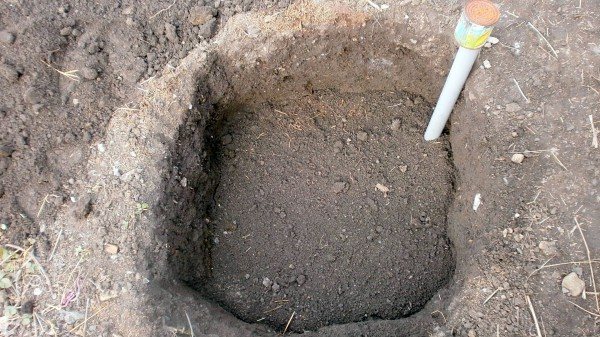

Despite the fact that this technology has fans, its concept is often criticized. According to experienced gardeners, this method of planting grapes has undeniable disadvantages: the drainage layer and the pipe will prevent the growth of roots, and watering through the pipe is often troublesome, and the creation of a smart pit requires unjustified effort and time.
Video: features of a pipe for irrigation.
Seedling preparation
Before starting in spring and autumn to prepare a grape seedling, you must carefully examine it. If you find any mechanical damage, mold, lesions, then, alas, such a specimen is not suitable for rooting.
You can prepare a grape seedling for planting in spring and autumn according to the following scheme:
- It is necessary to boil water and cool. Place the seedling in a cool liquid for about a day. If desired, for soaking, you can use a drug that stimulates the growth of roots (for example, soak the roots in a solution of the drug "Kornevin").
- After removing the seedling from the water, check the roots for damage.
- It is necessary to remove the roots at the top of the seedling, and cut the roots at the bottom by two centimeters.
- Then you should carry out a small pruning of the shoot (leave three or four eyes on it from the base of the shoot).
- Treat the seedling with drugs to prevent diseases and pests.
Direct landing
Planting grapes is carried out according to this scheme:
- Choose a suitable place, prepare the planting hole and seedlings according to the instructions in the paragraphs above.
- Pour a small pile of earth from the top fertile soil into the bottom.
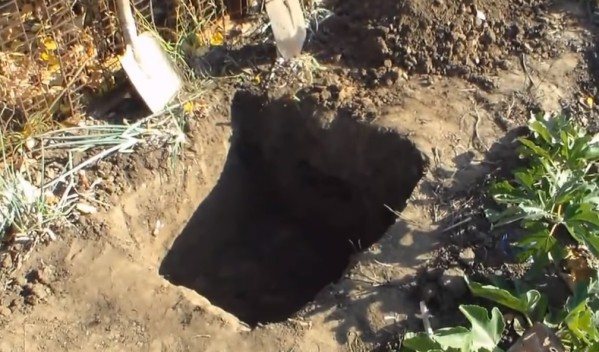

- Carefully place the seedling over this pile and spread the roots. They should be evenly spaced at the bottom of the pit.
- Then you should carefully fill the hole with soil.
- After that, water the planting site with three buckets of water, and if you have several bushes planted, then watering must be carried out under each bush.
- After watering, cover the seedling with a plastic bottle (cut off the bottom of it first). The bottle should be slightly deepened into the ground.
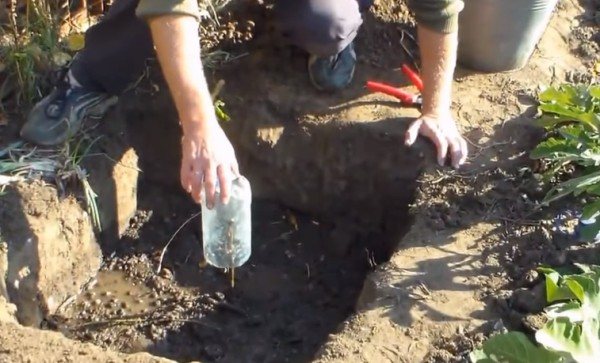

By following these simple step-by-step instructions for planting grapes correctly in autumn and spring, you can successfully root a plant that will give you delicious berries in the future. Even a novice gardener can cope with planting grapes with seedlings on his site.
Recommended distance between seedlings when plantinge - about one or one and a half meters in a row. If you plan to plant a lot of seedlings, it is wise to produce planting future bushes in a trench. Tearly technique requires trench preparation in the same way as in the case of a conventional pit preparation.
Video: features of the trench method.
Planting grape seedlings
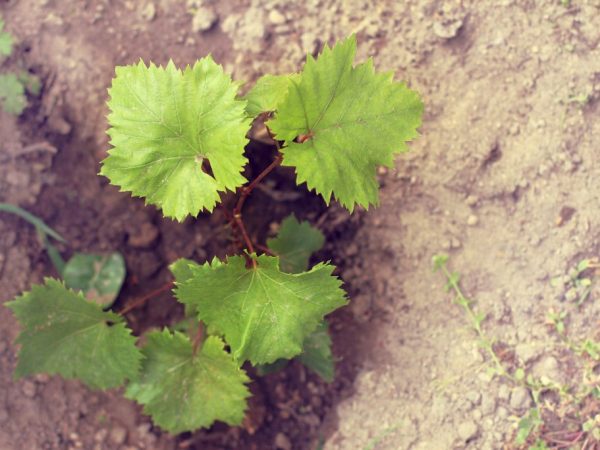

Plants need good lighting
For annual and perennial grapes, the soil, lighting, additional conditions are prepared: these requirements are the same for autumn and spring planting. During this period, watering, fertilizing the soil, introducing mineral complexes into the soil. Spring disembarkation is a multi-step process.
Preparing for planting in spring includes:
- selection of a suitable variety for the selected region (taking into account the climate, humidity, temperature difference in the region);
- soil preparation (the soil is abundantly watered, fertilized, dug up and loosened);
- choosing a suitable place where there should be no drafts or dampness.
It is important to take into account how the state of the soil and the ambient temperature will change: for annual and perennial grapes, a secluded place is selected, where it is easy to make additional shelter.
The planting of grapes is organized on the basis that in 2 months the soil will settle down and the correct moisture will be established. Watering should only be additional: the rhizome receives the main nutrients and moisture from the soil. Preparing for planting a crop will ensure its rapid and correct growth.
The choice of planting material
How to properly plant grapes in spring with a seedling: the quality of the future culture depends on the selected variety, therefore, planting grapes begins with the choice of planting material. The following criteria help to choose a variety:
- diseases that are tolerated by the bushes of the variety;
- average growth rate;
- resistance to diseases of other horticultural crops.
The most unpretentious planting material is annual. These are shoots with 3-4 roots. The total length of the planting material is up to 12 cm (choosing a long material is ineffective). It is important to choose a stalk no thicker than 3-4 mm in diameter: it will quickly take root even without additional fertilization. A prerequisite for planting a shoot is soaking in a disinfectant solution. Such actions help to kill the pathogenic flora that multiplies on the selected material.
To plant a seedling, 2 days before that, it is placed in a special solution. To prepare it, you will need 10 parts of water, 400 g of clay and 200 g of hexachlorane. Dry shoots require additional moisture. Before planting them, the cutting is poured with water and left so for 2-3 days.
If the seedling has damaged roots, they are urgently removed. Before planting, the material is carefully checked: do not plant damaged sections, stems with spots or signs of decay. No more than 4-5 eyes are left on the shoot. 2-3 hours before the main event, the material is left in fertilizer: 1 part of manure and 2 parts of a growth-stimulating substance are thoroughly mixed. The mixture is diluted with water, and after soaking, it is added to the soil for feeding.
Seat selection


Plant grapes in an area without lowlands
How to plant young grapes with seedlings in spring: choose a suitable place where the culture will definitely grow for many years in a row.If a gardener plans to grow grapes, they choose a place where the vines can grow and will not interfere with other garden crops.
Where to plant grapes in spring with seedlings:
- in an area with good lighting;
- in an area with no lowlands;
- on a plot with fertile soil.
Shine
The main condition for a good harvest is the lighting of the site. Planting grapes in spring with seedlings involves choosing a site away from the shade: the less light, the less sugar in the berries. The grapes grown in the shade are sour and the clusters are small. Lighting should be uniform: the light falls on the entire surface of the bush, and not on one of its sides.
Moisture
Grape seedlings grow poorly in spring if excess moisture is constantly collected on the soil. In the lowlands, water is constantly collected (if it rains often, such stagnant water is a source of diseases from other horticultural crops). Due to an excess of moisture, the root system of the bush rots, and the vines wither quickly. Before planting grapes, the relief of the selected area is calculated.
The soil
The decisive condition for planting grapes is the composition of the soil: choose areas for planting with fertile soil. If the soil is not of the best quality, and the gardener does not have another site, a special planting pit is prepared: it is fertilized and moistened soil, which is constantly fed with mineral additives. A fertile layer for grapes requires humus and mineral salts. For the rapid growth of shoots, a good soil moisture capacity is needed.
Choosing a suitable period
When is it better to plant grape seedlings: in spring, after warming, when the upper layers of the soil have warmed up. The exact planting time is determined by the crop variety and the region in which the land plot is located. Trees are planted only at a minimum ambient temperature of 15 ° C. The average soil temperature should be at least 10 ° C. If the spring turned out to be cold, you should not rush to plant the material. Weak roots can die due to frozen soil layers.
A suitable time for planting vegetative materials is from March to June. Many are not afraid to carry out work on planting horticultural crops at the beginning of summer: if you fertilize and moisten the soil with high quality, the shoot will get stronger until autumn and will be able to survive the winter.
2 types of shoots are planted in open ground: vegetative and woody.
Vegetative
The first type of seedlings is planted in the spring, they are young. Such material is sold with a soil mixture, it is suitable for urgent planting in open ground. There is at least one leaf on vegetative materials, which indicates the ability of the shoot to grow. It is planted from May 20 to June 20.
Stiffened
The second type of planting material germinated in the ground, but for the winter it was transplanted into a container and left in a warm room. Such a seedling has a well-developed root system, there are buds on the stem. This material is best planted in early spring.

